2012年04月04日
Battlefield Boomsticks
私たちのブログを訪問していただきありがとうございます。あなたがお持ちの場合DIYの要求は私達に電子メールを送信してください。
A roundup of special-purpose 12 gauges in use by the most elite forces.
Benelli M4 Tactical

Italian gun maker Benelli is world-renowned for its tactical shotguns. Models such as the SuperNova Tactical, M2 Tactical, M3 Convertible, and M4 Tactical are in service with the special operations units of Italy, France, Estonia, Macedonia and the United Kingdom, among many others. Benelli’s SuperNova Tactical is a pump-action shotgun that features a lightweight receiver that is noted for its strength. It is available with either rifle sights or adjustable ghost ring sights. The M2 Tactical, like many Benelli semi-automatic shotguns, is inertia driven and uses recoil to operate the action. This reduces many of the problems associated with gas-operated systems, such as the tendency to malfunction in adverse environments and due to burnt residue fouling.
C-MORE Systems M26

One of the newer concepts in the field of combat shotguns is the M26 Modular Accessory Shotgun System (MASS). In service with the U.S. Army, the M26 is a modular firearm that is primarily designed to be attached as an accessory to an M4 Carbine or other assault rifles. When attached to an M4, the M26 can be zeroed to the optical or iron sights of the host weapon. The M26 can also be detached from the host rifle, have an M4-type collapsible buttstock attached and used independently in confined spaces such as vehicles and building interiors. In the standalone role, an optical sight can be installed using an integral Picatinny accessory rail.
Izhmash Counter-Terror KS-K 12

Elite Russian Spetsnaz, or Special Purpose Troops, of the army’s GRU intelligence branch and the FSB’s Alfa Counter Terrorism Unit use a unique combat shotgun based on the Kalashnikov operating system. Known as the KS-K, this military shotgun is produced in Russia by the Izhmash Company. A civilian-legal variant of this shotgun is sold in the U.S. under the Saiga brand name. The KS-K shotgun is similar to the Kalashnikov assault rifle in both layout and operation. One benefit of this: Shooters familiar with the AK family of rifles can be easily cross-trained to use the KS-K. Unlike the rifles it is based on, however, the KS-K is semi-auto only. An AK-74-style side-folding stock is used on the KS-K.
By Christian Shepherd
BLOG ARCHIVES

2012年03月30日
CT-71 Anti Terrorist
私たちのブログを訪問していただきありがとうございます。あなたがお持ちの場合DIYの要求は私達に電子メールを送信してください。
An exclusive look at the training and weapons of Jordan’s elite CT-71 Battalion.

With a cutting edge training facility, a certified special operations leader and the latest in decisive firepower, Jordan’s CTB-71 is ready to protect and serve. CTB-71 point man hurries towards the breach point with his G36, equipped with EOTech’s holo sight. The G36 carbine is easily adaptable to various counter-terror missions and environs.
“30 seconds, 30 seconds.”
I hear the time hack called through my ear protection and helmet as our Suburban rolls at high speed, locked and loaded through the desert. Terrain is sparse and bare: undulating hills with block houses and dirt patches as far as the horizon. The city is the desert and the desert is the city; There is no distinction in terrain or color. We’re moving fast, the sensation of speed magnified by proximity to the ground. This and the fact that I’m standing on the extended running board at the rear right position outside the suburban has my heart rate elevated and a broad smile across my face.
“10 seconds, 10 seconds.”
The call is repeated by the mission team leader in the lead vehicle of our two-vehicle assault element. Other team members and I have just enough time to do final gear checks— press checking rifles confirming they’re “hot,” re-verifying that optics are on and working, and a quick visual re-check that no mission-essential gear has fallen during our trip to the target. Not that it would matter. Time’s up.
“Go, go, go.”
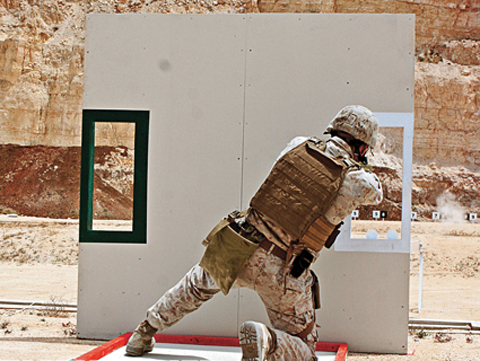
U.S. Marine fires a .45-caliber pistol at a target during a precision marksmanship contest at King Abdullah II Special Operations Training Center in Jordan.
The team leader didn’t need to say it. The rapid deceleration and sudden stop of the up-armored Suburban served as an easy and simple indicator. Step off the board. Hit the ground running. We’re on target and it’s time to move. My boots hit the ground as I hop from my spot at the rear of the lead assault vehicle and I make my way toward our initial breach point. In front of me, my team members bring up their rifles and scan the area of the surrounding rooftops and pathways—areas meant to serve as streets and thoroughfares, but that are no more than alleys and cart paths. I can see people on the objective. Are they friendlies? They’re focused on what we’re doing with a casual observance—a tilt of the head and an expression of wonder and disbelief. It reminds me of when you’re driving through the heartland of America past miles and miles of crop land and come across a random piece of abandoned farm machinery, baked by the sun, derelict, sitting in the middle of a field. You look at it, recognizing it for what it is but also registering that it’s not supposed to be there but you say to yourself anyway, “why wouldn’t it be…”
By Matthew Graham
BLOG ARCHIVES

An exclusive look at the training and weapons of Jordan’s elite CT-71 Battalion.

With a cutting edge training facility, a certified special operations leader and the latest in decisive firepower, Jordan’s CTB-71 is ready to protect and serve. CTB-71 point man hurries towards the breach point with his G36, equipped with EOTech’s holo sight. The G36 carbine is easily adaptable to various counter-terror missions and environs.
“30 seconds, 30 seconds.”
I hear the time hack called through my ear protection and helmet as our Suburban rolls at high speed, locked and loaded through the desert. Terrain is sparse and bare: undulating hills with block houses and dirt patches as far as the horizon. The city is the desert and the desert is the city; There is no distinction in terrain or color. We’re moving fast, the sensation of speed magnified by proximity to the ground. This and the fact that I’m standing on the extended running board at the rear right position outside the suburban has my heart rate elevated and a broad smile across my face.
“10 seconds, 10 seconds.”
The call is repeated by the mission team leader in the lead vehicle of our two-vehicle assault element. Other team members and I have just enough time to do final gear checks— press checking rifles confirming they’re “hot,” re-verifying that optics are on and working, and a quick visual re-check that no mission-essential gear has fallen during our trip to the target. Not that it would matter. Time’s up.
“Go, go, go.”

U.S. Marine fires a .45-caliber pistol at a target during a precision marksmanship contest at King Abdullah II Special Operations Training Center in Jordan.
The team leader didn’t need to say it. The rapid deceleration and sudden stop of the up-armored Suburban served as an easy and simple indicator. Step off the board. Hit the ground running. We’re on target and it’s time to move. My boots hit the ground as I hop from my spot at the rear of the lead assault vehicle and I make my way toward our initial breach point. In front of me, my team members bring up their rifles and scan the area of the surrounding rooftops and pathways—areas meant to serve as streets and thoroughfares, but that are no more than alleys and cart paths. I can see people on the objective. Are they friendlies? They’re focused on what we’re doing with a casual observance—a tilt of the head and an expression of wonder and disbelief. It reminds me of when you’re driving through the heartland of America past miles and miles of crop land and come across a random piece of abandoned farm machinery, baked by the sun, derelict, sitting in the middle of a field. You look at it, recognizing it for what it is but also registering that it’s not supposed to be there but you say to yourself anyway, “why wouldn’t it be…”
By Matthew Graham
BLOG ARCHIVES

2012年03月25日
S.W.A.T. Knocks
私たちのブログを訪問していただきありがとうございます。あなたがお持ちの場合DIYの要求は私達に電子メールを送信してください。
Dynamic vs. covert entry: Which tactic will keep your team in the fight?

Dynamic entry requires S.W.A.T. operators to saturate a structure and dominate the occupants. The success of dynamic entry is based on surprise, speed, and violence of action.
Dynamic Entry
Thanks to the influence of television and movies, when most people think of S.W.A.T., the image they conjure up is probably of a team of well-equipped, black-clad police officers armed to the teeth, kicking in doors and moving through a structure with reckless abandon in search of the bad guys. In the movies, this often leads to a dramatic Hollywood-style shootout, but in real life, dynamic entry is designed to overwhelm the occupants of the target structure and ultimately lead to compliance without a shot being fired.

Each team member must fully understand his area of responsibility. Here, two operators address a door while a third covers their proverbial sixes.
Surprise Element
Whether considering individual or team combative tactics, surprise is a crucial factor. The goal should always be to attack when the adversary is off-guard. Surprise can be achieved through stealth movement to the breach point, a loud breach, the use of noise-flash diversionary devices and aggressive movement by team members. Unfortunately, during the service of most search warrants, the knock and announce requirement negates the element of surprise. This could give occupants ample time to formulate a plan to destroy evidence or worse yet, arm themselves.
Speed Factor
While speed is essential during a dynamic entry, an operator should not move faster than his brain can process information or faster than he could accurately shoot. It does no good to run through the structure and miss a critical piece of information or fail to detect a threat. Far too many officers have literally rushed to their death when there was no real urgency.

From behind the cover of a ballistic shield, a S.W.A.T. operator prepares to deploy a diversionary device.
By Richard Nance, Images by Alfredo Rico
BLOG ARCHIVES

2012年03月11日
The U.S. Ice Men
私たちのブログを訪問していただきありがとうございます。あなたがお持ちの場合DIYの要求は私達に電子メールを送信してください。
The ICE Special Responders cometh bringing high-speed efficiency and low-drag force as required!

U.S. ICE Homeland Security SRT agents are highly trained and experienced Federal S.W.A.T. cops who conduct all types of tactical operations including vehicle takedowns, open air assaults and the execution of high risk warrants.
It’s early in the morning when a human smuggler’s front door is breached by U.S. Immigration & Customs Enforcement HSI (Homeland Security Investigations) SRT (Special Response Team) Special Agents. Within 30 seconds the location is secured and the subject of a major criminal investigation is in federal custody. This isn’t a TV episode about federal agents, this is an example of the tactical operations that U.S. ICE SRT agents perform on a regular basis in 12 different parts of the United States. ICE also maintains five additional certified SRT units that are managed by ICE Detention and Operations.
Back in the “good old days” it was standard operating procedure for a federal agent or a detective to work a case from beginning to end, which included hunting down the guilty party and making one or more arrests, under any and all circumstances—without any assistance from a tactical team, as very few existed. Those of us who worked in law enforcement during most of the 20th Century often had to breach a door by kicking it in or using some type of subterfuge so we could gain access to a location and make as many arrests as were required to solve a case.
During the latter part of the last century, LE officers from various agencies were routinely kicking doors or taking subjects down in car stops and buy-bust situations. During this intense period of smuggling activity, the U.S. Customs Service evolved into a very progressive and highly successful interdiction and investigative agency. Due to the number of high-risk enforcement actions being executed on a regular basis, the U.S. Customs Service decided to establish a tactical unit called the WETT (Warrant Entry Tactical Team). In time, the U.S. Customs Service changed the name of its tactical team to the Special Response Team.

U.S. ICE SRT Agents from Homeland Security Investigations train to move fast while being incredibly methodical in their approach to tactical operations.
By Nick Jacobellis, Images by Alex Landeen
BLOG ARCHIVES

2012年03月11日
U.S.M.C. Scout Snipers
私たちのブログを訪問していただきありがとうございます。あなたがお持ちの場合DIYの要求は私達に電子メールを送信してください。
McMillan/Remington M40A3. The USMC’s M40A3 is assembled by the Precision Weapons Section in Quantico VA, with parts provided by several manufacturers. This makes it a unique weapons system.

BLOG ARCHIVES

2012年03月07日
Ral World Ratpacking
私たちのブログを訪問していただきありがとうございます。あなたがお持ちの場合DIYの要求は私達に電子メールを送信してください。
GET INTO the MOST portable, realistic and transformable shooting house.

Members of a U.S. Air Force tactical team enter from the stairwell.
As a S.W.A.T. team member and police trainer, I can attest that finding new and realistic training environments presents a dilemma. Typically, officers are relegated to training in only a handful of structures, day in and day out. Before long, team members can’t help but memorize the floor plans of these structures. Training value is diminished since officers are no longer required to read the layout of the structure as they would during an actual operation.
Thanks to UXB International, Inc., providing realistic training to law enforcement and military personnel just got a whole lot easier. According to its creator, Mike Warminsky, the Reconfigurable Armored Tactical Personnel and Collective (RATPAC) training system is the result of a blue-ribbon panel of Spec Ops and LE professionals tasked with developing a “train as you fight” environment. As such, RATPAC was designed to be the ultimate training ground for both the War on Terror and the war on drugs.
Tactical Weapons recently attended an interactive demonstration showcasing RATPAC. The event was hosted in conjunction with Awareness Protective Consultants, CUBIC Corporation, SMH International, and the U.S. Army. This free train-the-trainer event, held in Orlando, Florida, focused on reaping the benefits of the RATPAC structure as well as incorporating sound tactics, essential for real-word mission success.
By Richard Nance
BLOG ARCHIVES

2012年03月04日
LMS Team Tactics
私たちのブログを訪問していただきありがとうございます。あなたがお持ちの場合DIYの要求は私達に電子メールを送信してください。
Since LE officers often work as a team, it’s important to train that way!

Learning the ins and outs of your gear in harsh environments can ensure that you and your team are prepared for any eventuality.
After a couple of decades serving as a police officer, the need to work with a partner becomes permanently imprinted. Fighting alone certainly happens, it is the nature of police work, but most agencies do their best to send officers in pairs or more to critical calls. Dealing with armed suspects alone should not be the plan. This is especially true for active shooter situations. In reality, this is often dependent on your department, staffing, and the luck of the draw, but for the most part, these situations are handled with a partner or a team. As a tactical team, military squad or contractor abroad, teamwork becomes even more critical.

To ensure training mirrors real-world conditions, it is advisable for LEOs to practice together as a unit in realistic conditions.
Many departments spend the majority of their training focused on the individual. For the most part, it is easier, can be less costly, and given the propensity for agencies to be supremely risk-focused, it is often safer. As training and tactics become more complex, they require significant attention, something many administration simply will not support. A recent trip to LMS Defense brought that point home, with a team tactics class and the added complication of adverse conditions.

Good training is more than simply operating your gun—it is employing it in situations an LEO might encounter under fire. A good example is reloading your rifle from the prone position.
LMS Defense
The LMS Defense facility is located about a half-hour outside Reno, Nevada. The facility has several ranges, including a 10,000-square-foot shoothouse. The primary environment is dust, dirt and some more dirt. Its composition is that of a fine talcum powder that gets into everything. This is the perfect environment for those who find themselves fighting in high desert. LMS Defense also teaches classes in Northern California, Arizona, Washington and several other places. John Chapman, the director, is a retired police lieutenant with many years as a trainer. He is also an experienced contractor having worked in the personal security field for years. The training is practical, well-tested, and geared towards anyone looking for real-world training. Needless to say, I was looking forward to attending.
Posted by Dave Bahde
BLOG ARCHIVES

2012年03月02日
Perfect 17th Stormo
私たちのブログを訪問していただきありがとうございます。あなたがお持ちの場合DIYの要求は私達に電子メールを送信してください。
Trained and armed to the teeth, Italy’s elite 17th Stormo Incursori forces are more than ready to raid behind enemy lines!

The Italian Air Force has a long tradition of elite ground units within its ranks. In fact, today’s 17th Incursori (which translates to “Raiders Wing”) traces its origins to the World War II ADRA (Arditi Distruttori Regia Aeronautica), which had the mission of attacking enemy airports and sabotaging enemy aircraft. This is similar to the mission for which the British Special Air Service was originally formed in North Africa during WWII. The ADRA also operated in North Africa, against allied airfields, destroying 25 B-17s in their most successful raid. In fact, today’s 17th Stormo Incursori is sometimes referred to as the “ADRA 17th Stormo Incursori.”
Prior to April 2008, the unit was known as RIAM (Reparto Incursori Aeronautica Militare)—the Air Force Raiders Group. Today, the 17th Stormo Incursori is based at Furbari, near Rome, and is assigned to COFS (Comando interforze per le Operazioni delle Forze Speciali), the Italian equivalent of SOCOM.

The SAKO TRG-42 in .338 Lapua Magnum is used by 17th Stormo for long-range sniping, such as against enemy aircraft on their airfields.
The 17th Stormo has four primary missions. They carry out combat search and rescue operations (CSAR), like our USAF PJs, and they act as combat controllers—maintaining Forward Air Control and Joint Terminal Attack Control—like our USAF CCTs. The Stormo also act as pathfinders for airborne, airmobile and air-landing operations. Further, they carry out direct action against airbases and other aviation assets; Stormo operators are trained to infiltrate enemy air bases and sabotage aircraft and facilities. A substantial number of operators are also trained as anti-materiel snipers using .338 Lapua or .50 BMG rifles to destroy aircraft and control systems from a distance.
By Leroy Thompson
BLOG ARCHIVES

2012年02月29日
Firefight Transitions
私たちのブログを訪問していただきありがとうございます。あなたがお持ちの場合DIYの要求は私達に電子メールを送信してください。
Life-saving time and space management skills for switching from long gun to handgun and back again!
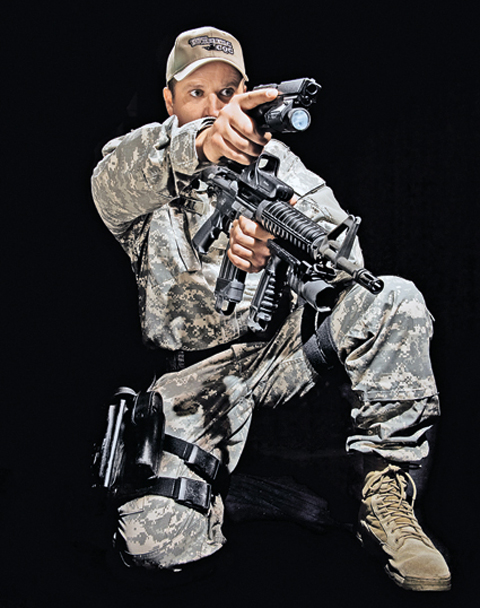
With practice, transitioning from your long gun to handgun can be accomplished very quickly. Here, the handgun is on target as the long gun is being slung. Taking a knee can also make you a smaller target as you fix your primary weapon.
It doesn’t take a brilliant strategist to realize that a long gun, such as an AR-15 or a shotgun, is typically preferable to a handgun in a gunfight. Superior ballistic performance and enhanced accuracy make the long gun your “primary” weapon, but there are bound to be times when it’s necessary to transition to your handgun.
When your primary weapon malfunctions or runs empty within your effective handgun range, you’re better off engaging the threat with your handgun than trying to fix your long gun. In a close-quarter environment, you might opt to transition from a fully functional long gun to a handgun for its maneuverability, which makes it easier to negotiate corners without the gun preceding your movement. The handgun, even at the ready, also affords you a free hand with which to open doors, move obstacles or fight. In any case, you need to be well versed in transitioning from one weapon to another to afford yourself every advantage during a high-stress encounter.
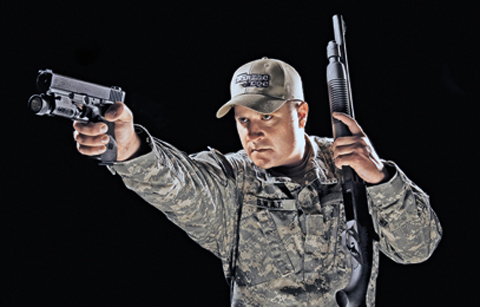
If in the event your long gun malfunctions and leaves you vulnerable, to transition without a sling, simply pull the long gun in close to your body while drawing your handgun.
Sling Considerations
There are several types of slings on the market. Two of the most popular and practical slings are the single-point and the two-point styles. As their name implies, single-point slings have only one point of contact to the weapon, which is typically attached to an aftermarket receiver plate. Two-point slings are usually affixed to sling mounts positioned along the barrel and stock, or strapped around the stock itself.
By Richard Nance, Images by Alfredo Rico
BLOG ARCHIVES

2012年02月28日
Dynamic Warriors
私たちのブログを訪問していただきありがとうございます。あなたがお持ちの場合DIYの要求は私達に電子メールを送信してください。
Run the gun and your mind through Magpul’s high-speed, low-drag carbine course with today’s top tactical operators!
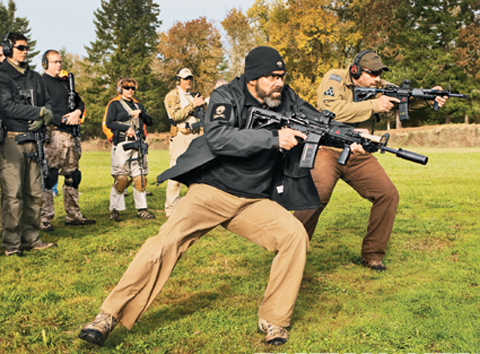
Little of the Magpul Dynamics course is standing on the flat range firing numbered shot counts. Students are taught to move, turn, problem solve and deliver accurate shots.
To check out the company that has sold more than 1.5 million polymer magazines and whose training division raised the bar on instructional videos with its Art of the Dynamic Carbine (1&2), Art of Dynamic Handgun and Aerial Platform Operations Series, TW stepped inside the Magpul Dynamics’ Dynamic Carbine Course in Hammond, LA to see if these guys are as good as their videos.
Dynamic Carbine 1: Building the Fundamentals
"We will give the students an honest snapshot of themselves, very quickly,” says Chris Costa, Magpul Dynamics Instructor. The Dynamic Carbine 1 course brought together shooters from across the country and throughout the range of shooting experience. There were several husband and wife attendees, a father and son, as well as law enforcement, hobbyists, and professional security contractors. After a detailed safety briefing, instructors Costa, Haley, and Olivella began building up the fundamentals in their students. Starting with basic body position, stance, and trigger control, the class moved to confirming zero on their optics. Once zeroed, in-depth work began on sight picture/sight alignment differences at ranges from 5 to 50 yards. Reload techniques such as speed (under fire), tactical (in action, but covered), and admin (no threat, get re-organized) were covered, as well as malfunction drills (double-feed, mag failure, mis-fire, stovepipe).
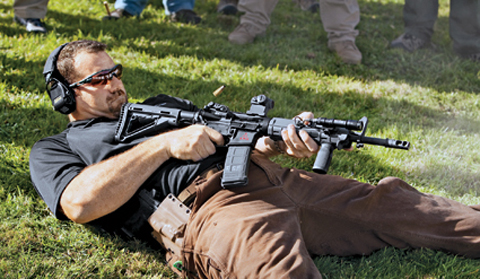
Instructor demonstrates the supine position. The position is a critical skill that allows shooter to tactically recover from a slip or dramatically reduce his profile while continuing to deliver well-aimed shots under fire.
As the course continued over the next three days, BSA drills (“Balance of Speed and Accuracy”) became a common element. The BSA drill measures timed rounds into an 8-inch center-mass circle on the man-sized Magpul targets. Students were encouraged to push their limits from standing, kneeling, and prone positions at varying distances. The targets told the tale: If the group was too tight with no hits outside the circle, speed was lacking. If the group was scattered outside the circle, the shooter should slow down and concentrate on body position and accuracy. This litmus test gave each student instant feedback at every drill as to how fast he/she could push the rifle and put combat-effective hits on the target.
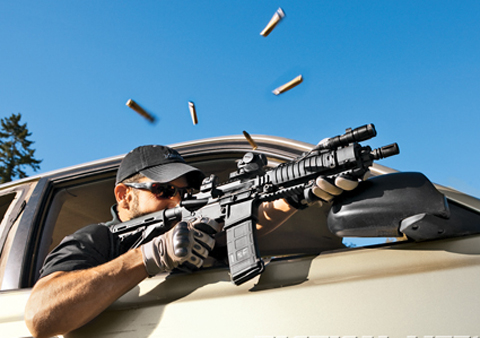
Magpul tests both decision making and weapons handling skills. Above, a student engages multiple targets from the open window of a vehicle.
On the afternoon of day two, the instructors conducted a “mini” handgun course. While the handgun is typically a class unto itself, the transition to the handgun in the event of a carbine malfunction at close range is a crucial skill and would become a part of many of our subsequent drills. Day three brought a significant increase in the pace of the drills, which now included weapons transitions, timed speed events, movement to multiple targets and barricade obstacle shooting. Dynamic Carbine 1 ended with shooters more confident, competent, and mindful than when they arrived.
from tactical-life
BLOG ARCHIVES

2012年02月26日
Navy Seals 50th Salute
私たちのブログを訪問していただきありがとうございます。あなたがお持ちの場合DIYの要求は私達に電子メールを送信してください。
Celebrating 50 years of service so that freedom and liberty reign supreme!

Tactical Weapons Group, founded by a NAVSOC vet, put together a 50th anniversary package durable enough for SEALs that includes the battle-ready FN SCAR 17, EOTech HWS, SOG Pup knife and more.
The concept that warfare tactics, methods and weapons change over time is a given. We see it today in the ways that America’s armed forces fight terrorists abroad. Looking back to 1962, when America’s presence in Vietnam was mostly at the advisory level, President Kennedy recognized the changing face of warfare and gave the thumbs up for the services to create their own special operation detachments. The Navy responded by commissioning two Sea Air Land Teams (SEALs). This year marks the SEALs’ 50th anniversary.
WWII-Korean War Roots
The SEALs take their roots from the Navy frogmen of World War II, marking the beginning of the modern-day Naval Commandos. Navy frogmen were trained in Ft. Pierce, Florida, in the early 1940s. Decades later, Congress designated this location as the official National Navy UDT-SEAL Museum.

SOPMOD accessories allow operators to modify the 7.62mm FN SCAR 17 for a successful mission in any environment. This TWG edition is officially SEAL sanctioned.
Because WWII had many different types of combat, the U.S. armed forces had to adapt. The U.S. Navy recognized the need for the covert reconnaissance of landing beaches and coastal defenses and commissioned “Scouts and Raiders,” an amphibious infiltration group, in October 1942. This group saw combat in November 1942 on the North African coast during Operation Torch, the first Allied landings in Europe. Scouts and Raiders also supported landings in Sicily, Salerno, Anzio, Normandy and southern France. Navy combat swimmers led the way, reconnoitering and clearing beaches full of obstacles, making it possible for Allied beach landings that proved critical to winning the war.
By Jay Langston
BLOG ARCHIVES

2012年02月25日
CQB Gun Control
私たちのブログを訪問していただきありがとうございます。あなたがお持ちの場合DIYの要求は私達に電子メールを送信してください。
Keep your gun out of the wrong hands with these S.W.A.T. techniques!

When approaching the breach point of a structure, a S.W.A.T. operator’s primary concern must be encountering an armed subject (maybe more than one) who is willing to kill or be killed to further their cause. S.W.A.T. must be capable of immediately responding with deadly force to overcome this high-level threat. To better their odds, S.W.A.T. personnel are typically more highly trained, better protected (with superior body armor) and more heavily armed than the average patrol officer. This means operators usually carry a rifle or shotgun as their primary entry weapon. While this is obviously beneficial in a firefight, wielding a long gun in tight quarters could lead to an operator’s weapon being grabbed.

The first “P” in C.O.P.P. stands for push. Here, the operator pushes the muzzle into the subject. If the muzzle actually strikes the subject, that’s even better. The final “P” stands for pulling back the rifle.
Imagine negotiating the corner of a building only to have a crazed suspect grab hold of your rifle with both hands. As you’re contemplating your next move, the suspect is trying to rip the rifle from your grasp. You consider shooting the subject, but since you’re unable to control the direction of the muzzle during the deadly tug of war, you know squeezing the trigger is not an option. If you’re not able to quickly and fully extract your weapon from the bad guy, you risk being disarmed, knocked to the ground and delaying the clearing of the structure. At times like this, you need a reliable default response to retain your weapon.
The Close-Quarter Hold
In the basic S.W.A.T. school I attended, the close-quarter hold was the only technique taught for long gun retention. For many operators, weapon retention begins and ends with the close-quarter hold, which is a viable, albeit somewhat limited option.

The close-quarter hold can be used to redirect non-combatants, but it has limited value against a determined assailant.
By Richard Nance, Images by Alfredo Rico
BLOG ARCHIVES



